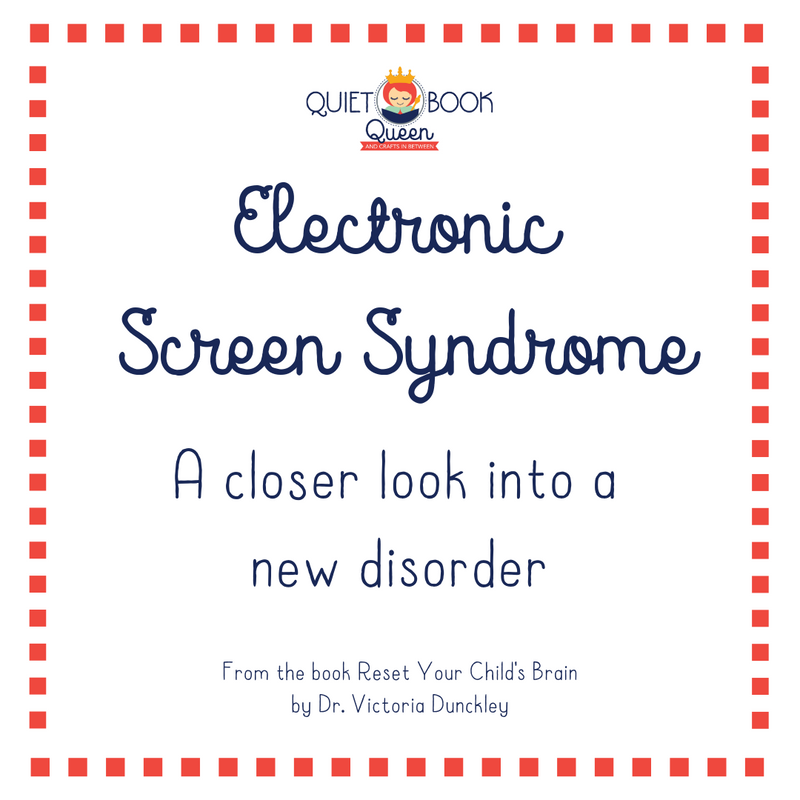
In her book Reset Your Child's Brain, Dr. Victoria Dunckley has coined the term Electronic Screen Syndrome (ESS) to help conceptualize how the repeated stress of screen time can affect our bodies.
What Interactive Screens Do To Our Bodies
You see, interactive screens are overstimulating to our nervous system. They trigger our bodies to go in to fight-or-flight mode, but we physically are not moving. This inconsistency leads to dysregulation of some of our biological systems, thus affecting our mood and behavior.
Often times the stress response is evident at the time of use (such as playing a game on an iPad), but surprisingly the response can be more subtle and take place gradually. Then it builds up after years of screen use and symptoms surface much later.
Dr. Dunckley compares electronics to a stimulant such as caffeine, amphetamines, or cocaine. She writes, "Electronic screen device use puts the body into a state of high arousal and hyperfocus, followed by a "crash". This overstimulation of the nervous system is capable of causing a variety of chemical, hormonal, and sleep disturbance in the same way stimulants can. And just as drug use can affect a user long after all traces of the drug are out of the body, electronic media use can affect the central nervous system long after the offending device is actually used."
Characteristics of Electronic Screen Syndrome

Now you may be thinking that of course young children can be irritable or have lack of impulse control, etc., but Dr. Dunckley says the symptoms will cause significant dysfunction in school, at home, or with peers. She also says that irritability and poor executive functioning (reasoning, judgment, task completion, planning, problem solving, and critical thinking) occur in most cases and are hallmarks of the disorder.
It is interesting to note that the symptoms of ESS can mimic or make worse any mental health-related disorder. Dr. Dunckley describes it as an "insidious shape-shifter". She discusses in her book how she recommends a screen fast to her new patients before putting them on medication, and she sees over and over what a difference it can make in the child's behavior.
Here are some other characteristics Dr. Dunckley mentions:
- "Stressed out," "revved up," "wired," or "out of it" are often terms used to describe children with ESS. Families say they "have to walk on eggshells" around the child.
- After strictly removing interactive electronic media for several weeks (at least three), the symptoms improve or completely resolve.
- Symptoms can recur once screen devices are reintroduced.
- Often a child will be drawn to screen devices and it is hard to pull them away.
- These factors increase the risk for ESS - male gender, younger age, preexisting psychiatric, neurodevelopmental, learning, or behavior disorders, addiction tendencies or family history of addiction, younger age when first exposed to screen time, and higher amounts of total lifetime exposure.
What To Do If You Are Concerned
If you can relate to any of the information above, I highly suggest you read or listen to Dr. Dunckley's book called Reset Your Child's Brain: A Four-Week Plan to End Meltdowns, Raise Grades, and Boost Social Skills by Reversing the Effects of Electronic Screen Time.
She will walk you through what you need to do to begin a screen fast to see if your child's behavior improves. She tells you how to prepare for the fast in advance, how to get everyone on board, how to support your child through this process, and the reactions you may see. She provides so many case studies of patients she has worked with and their positive results at the end.
For Anyone With Young Children
Even if you haven't seen these symptoms in your child, now you can be aware of what to look out for. If you notice a marked change in your child's behavior, keep screen time in mind.
You can delay screen use as long as possible, as exposure to screen time at a younger age can be a contributing factor to ESS. You can also set limits on screen time and enforce them. But what's concerning to me is that Dr. Dunckley suggests it can build up over time with just mild use. We limit screen time in our family, but it worries me that it still might not be enough. It also troubles me how much screens are used in schools these days, and this could contribute to a child's behavior.
Every child is different though when it comes to how much screen time he/she can tolerate. So the best we can do is be mindful of screen time and a child's behavior, and know to try a screen fast if issues arise!
If you'd like screen-free activity ideas for your little ones, more information on the effects of screens, or are interested in making a Quiet Book subscribe to my newsletter here!


0 comments